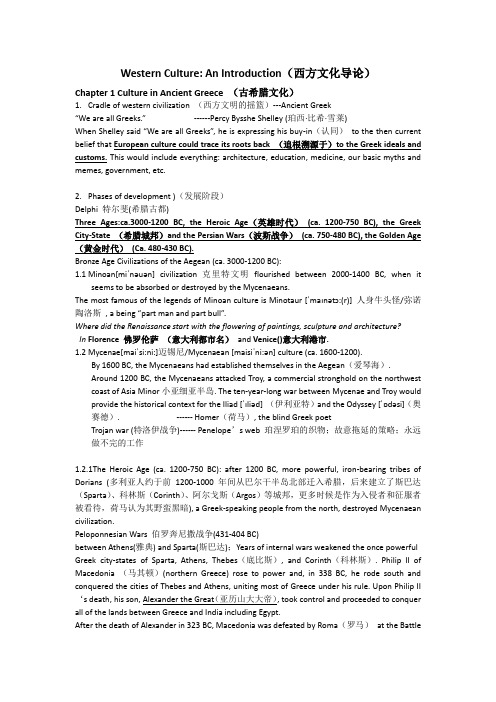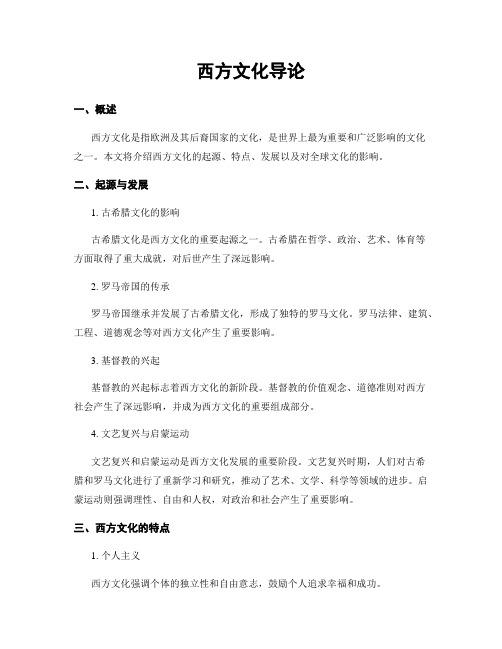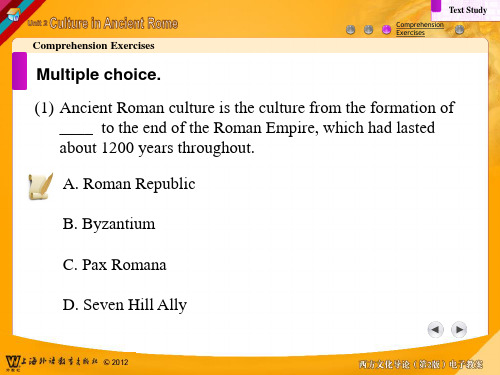西方文化导论2
西方文化导论

Western Culture: An Introduction(西方文化导论)Chapter 1 Culture in Ancient Greece (古希腊文化)1.Cradle of western civilization (西方文明的摇篮)---Ancient Greek“We are all Greeks.”------Percy Bysshe Shelley (珀西·比希·雪莱)When Shelley said “We are all Greeks”, he is expressing his buy-in(认同)to the then current belief that European culture could trace its roots back (追根溯源于)to the Greek ideals and customs. This would include everything: architecture, education, medicine, our basic myths and memes, government, etc.2.Phases of development )(发展阶段)Delphi 特尔斐(希腊古都)Three Ages:ca.3000-1200 BC, the Heroic Age(英雄时代)(ca. 1200-750 BC), the Greek City-State (希腊城邦)and the Persian Wars(波斯战争)(ca. 750-480 BC), the Golden Age (黄金时代)(Ca. 480-430 BC).Bronze Age Civilizations of the Aegean (ca. 3000-1200 BC):1.1Minoan[miˈnəuən] civilization 克里特文明flourished between 2000-1400 BC, when itseems to be absorbed or destroyed by the Mycenaeans.The most famous of the leg ends of Minoan culture is Minotaur [ˈmaɪnətɔ:(r)] 人身牛头怪/弥诺陶洛斯, a being “part man and part bull”.Where did the Renaissance start with the flowering of paintings, sculpture and architecture?In Florence 佛罗伦萨(意大利都市名)and Venice()意大利港市.1.2Mycenae[maiˈsi:ni:]迈锡尼/Mycenaean [maisiˈni:ən] culture (ca. 1600-1200).By 1600 BC, the Mycenaeans had established themselves in the Aegean(爱琴海).Around 1200 BC, the Mycenaeans attacked Troy, a commercial stronghold on the northwest coast of Asia Minor小亚细亚半岛. The ten-year-long war between Mycenae and Troy would provide the historical context for the Iliad [ˈɪliəd] (伊利亚特)and the Odyssey [ˈɒdəsi](奥赛德). ------ Homer(荷马), the blind Greek poetTrojan war (特洛伊战争)------ Penelope’s web 珀涅罗珀的织物;故意拖延的策略;永远做不完的工作1.2.1The Heroic Age (ca. 1200-750 BC): after 1200 BC, more powerful, iron-bearing tribes of Dorians (多利亚人约于前1200-1000年间从巴尔干半岛北部迁入希腊,后来建立了斯巴达(Sparta)、科林斯(Corinth)、阿尔戈斯(Argos)等城邦,更多时候是作为入侵者和征服者被看待,荷马认为其野蛮黑暗), a Greek-speaking people from the north, destroyed Mycenaean civilization.Peloponnesian Wars 伯罗奔尼撒战争(431-404 BC)between Athens(雅典) and Sparta(斯巴达);Years of internal wars weakened the once powerful Greek city-states of Sparta, Athens, Thebes(底比斯), and Corinth(科林斯). Philip II of Macedonia (马其顿)(northern Greece) rose to power and, in 338 BC, he rode south and conquered the cities of Thebes and Athens, uniting most of Greece under his rule. Upon Philip II ‘s death, his son, Alexander the Great(亚历山大大帝), took control and proceeded to conquer all of the lands between Greece and India including Egypt.After the death of Alexander in 323 BC, Macedonia was defeated by Roma(罗马)at the Battleof Cynoscephalae(基诺斯山战役)in 197 BC and then again at the Battle of Pydna(皮德纳战役)in 168 BC. The Greeks were finally defeated at the Battle of Corinth in 146 BC. Rome completely destroyed and plundered(掠夺)the city of Corinth as an example to other Greek cities.1.2.2The Greek City-State and the Persian Wars (ca. 750-480 BC)In 490 BC, Battle of Marathon 马拉松战役In 480 BC, Battle of the Hot Gates and Battle of Salamis 萨拉米斯海战Persian Wars(希波战争): Herodotus 希罗多德(ca. 485-425 BC), the father of history 历史之父。
Unit10西方文化导论课件

Get Started
In a way the change of the cultural and intellectual climate in this period had something to do with romanticism and cultural trend of the time. More radical modes of creation appeared, first in poetry and then spread to other forms of writing and art. They were more rebellious, more radical, more opposed to tradition and social reality and more concerned with their own forms of subjective representation. Such a changed approach moved eventually into modernism.
Get Started
Modernism was born at the turn of the 20th century and swept many countries. Many social and psychological problems found expression in cultural and literary form, thus representing the real mood and emotion of the ordinary people in the West who were torn by countless troubles arising out of the social, political and cultural contradictions and clashes.
西方文化导论课程设计 (2)

西方文化导论课程设计一、课程简介本课程旨在让学生对西方文化有一个全面、深入的了解,了解西方文化的发展历程、主要特征、哲学思想、艺术及音乐等方面的内容。
通过学习本课程,学生能够更好地理解西方文化的内在逻辑和精神内涵,并在此基础上进行跨文化的交流和沟通。
二、课程目标1.掌握西方文化的基本发展历程和主要特征;2.理解西方哲学思想的基本概念和核心内容;3.熟悉西方文艺(尤其是绘画和音乐)的主要流派和代表作品;4.能够运用所学知识分析和解读西方文化中的现象和事件;5.增强对跨文化交流的认识和能力。
三、课程大纲第一章西方文化的发展历程1.西方文化的来源和演变2.古典文化和中世纪文化3.文艺复兴和宗教改革4.现代时代和当代文化第二章西方哲学思想1.古希腊哲学思想2.基督教哲学思想3.文艺复兴以后的哲学思想4.当代哲学思想第三章西方文艺1.绘画艺术–文艺复兴时期的艺术–印象派和后印象派画家–现代派和当代艺术家2.音乐艺术–古典音乐的发展–流行音乐和摇滚乐–当代音乐和音乐创作四、教学方法本课程采用多种教学方法,包括但不限于:1.讲授2.群体讨论3.个案分析4.视频观看5.案例分析五、教学评估本课程考核包括平时成绩和期末考试两个部分,具体如下:1.平时成绩(50%)–课堂表现(20%)–课程作业(20%)–小组讨论和辩论(10%)2.期末考试(50%)–笔试(40%)–口试(10%)六、参考资料1.《西方文化:历史与文化》(郭晓勇)2.《西方哲学史》(戴季陶)3.《西方音乐史》(约瑟夫·科辛斯基)七、结语本课程为一门全面、系统地介绍西方文化的课程,旨在激发学生的跨文化兴趣和能力。
应用多种教学手段,培养学生的独立思考和创造能力,使其在未来的学习和工作中更具有竞争力。
西方文化导论

西方文化导论一、概述西方文化是指欧洲及其后裔国家的文化,是世界上最为重要和广泛影响的文化之一。
本文将介绍西方文化的起源、特点、发展以及对全球文化的影响。
二、起源与发展1. 古希腊文化的影响古希腊文化是西方文化的重要起源之一。
古希腊在哲学、政治、艺术、体育等方面取得了重大成就,对后世产生了深远影响。
2. 罗马帝国的传承罗马帝国继承并发展了古希腊文化,形成了独特的罗马文化。
罗马法律、建筑、工程、道德观念等对西方文化产生了重要影响。
3. 基督教的兴起基督教的兴起标志着西方文化的新阶段。
基督教的价值观念、道德准则对西方社会产生了深远影响,并成为西方文化的重要组成部分。
4. 文艺复兴与启蒙运动文艺复兴和启蒙运动是西方文化发展的重要阶段。
文艺复兴时期,人们对古希腊和罗马文化进行了重新学习和研究,推动了艺术、文学、科学等领域的进步。
启蒙运动则强调理性、自由和人权,对政治和社会产生了重要影响。
三、西方文化的特点1. 个人主义西方文化强调个体的独立性和自由意志,鼓励个人追求幸福和成功。
2. 科学与技术的重视西方文化崇尚科学与技术的发展,注重实证主义和理性思维,推动了现代科学的进步。
3. 民主与法治西方文化倡导民主政治和法治社会,注重个人权利和平等,推动了现代民主制度的发展。
4. 艺术与文学的创新西方文化在艺术与文学领域具有创新精神,不断探索新的表达形式和艺术风格。
四、西方文化对全球的影响1. 语言和文学英语作为西方文化的代表语言,成为国际交流和商务的重要工具。
西方文学作品如莎士比亚的戏剧、浪漫主义文学等对全球文学产生了深远影响。
2. 科学与技术西方文化的科学与技术成果对全球产生了广泛影响,如工业革命、电子技术、计算机科学等。
3. 政治与法律西方文化的民主制度和法治观念对全球政治和法律体系的发展产生了重要影响。
4. 艺术与娱乐西方音乐、电影、时尚等艺术与娱乐形式在全球范围内受到广泛欢迎,成为全球流行文化的一部分。
五、结论西方文化作为世界上最重要和广泛影响的文化之一,其起源、发展、特点以及对全球的影响都具有重要意义。
西方文化概论2

西方文化的两大根源1、源自古希腊哲学的理性传统2、犹太-基督教传统、犹太-
两种思维或话语模式:两种思维或话语模式: Logos vs. Mythos
The Greek word LOGOS designates a certain kind of thinking about the world, a kind of logical analysis that places things in the context of reason and explains them with the pure force of thought. Such an intellectual exercise was supposed to lead to wisdom (Sophia), and those who dedicated themselves to Logos were thought of as lovers of wisdom (love =), hence as philosophers.
《西方文化导论》课程教学大纲.doc

《场方夂祀概崎》教曇丈詢学时:16课时学分:1学分授课对象:全校二年级、三年级学生教材:《四方文化概略》一、课程性质、目的和任务本课程是面向全校二年级、三年级学生设置的全院公共任选课程,旨在实现大学英语教学的个性化教育与综合索质培养的目标。
课程面向广犬学生,满足学生了解西方文化的个性化要求,结合语言学习,综合提高学生语言文化能力。
课程设置上按照时间的顺序对以欧洲文化为核心的西方文明进行导论性的介绍,内容包括古希腊、古罗马文化、文艺复兴、科学革命等对现代文化影响深远的古代文明及历史时期。
每个核心主题屮所涉及内容的选取侧重于文化继承和影响,结合语言方面的相关知识,综合介绍给学生。
二、教学基本要求本课程将英语语言文化背景知识系统的呈现给学生。
面向已具有一定的语言基础的二、三年级学生,课程内容的重心落在背景知识和文化了解的角度。
通过系统的内容丰富的语言文化知识的介绍,帮助学生更真切地掌握语言的深意和内涵,同时,开阔学生的视野,使学生得到全方位发展。
三、教学基本内容周次教学内容课时第二周爱琴文明与希腊神话传说2第三周希腊时期的文化2第四周罗马时期的文化2第五周中世纪时期的基督教文化2第六周文艺复兴时期的文化2第七周宗教改革时期的文化2第八周复习总结2笫九周课程考查2四、教学重点:第一章爱琴文明与希腊神话传说克里特文化的形成、成就和影响;迈锡尼文化的特点;荷马史诗的形成与成就。
1・克里特文化:建筑、壁画和彩陶、文字、宗教。
2. 迈锡尼文化:建筑、文字。
3. 荷马时代文化:《荷马史诗》、陶艺。
第二章希腊时期的文化希腊神话的内容与特点、古希腊宗教;古风吋代的希腊文学与艺术;古典吋代的希腊悲喜剧代表作家与作品,建筑、雕刻、哲学、科学和史学的成就。
新喜剧;亚历山大里亚、小亚细亚的雕刻艺术;亚历山大里亚城的建筑;犬儒学派、伊壁鸠鲁学派、斯多喝学派、怀疑论学派;希腊化时代的宗教特点及科学成就。
1 •早期希腊的文化:神话和宗教,文字和文学,艺术。
西方文化导论Unit2

Multiple choice.
Text Study
Comprehension Exercises
(1) Ancient Roman culture is the culture from the formation of ____ to the end of the Roman Empire, which had lasted about 1200 years throughout.
Comprehension Exercises
True of false question.
Text Study
Comprehension Exercises
பைடு நூலகம்
_F_ (1) In ancient Rome, freed slaves could become Roman citizen without any restrictions on their legal rights.
A. Octavian and Caesar B. Caesar and Remus C. Romulus and Remus D. Romulus and Octavian
Comprehension Exercises
Multiple choice.
Text Study
Comprehension Exercises
A. Julius Caesar, Mark Antony, Sulla B. Pompey, Crassus, Cleopatra C. Pompey, Crassus, Julius Caesar D. Octavian, Brutus, Marius
Text Study
西方文化导论人物对应的思想理论

西方文化导论人物对应的思想理论一、古希腊(小国寡民,城邦,民主,伦理)(一)苏格拉底1、知识即美德2、应由智者管理国家(二)柏拉图1、君主制,哲学王2、三大阶级:统治者、护卫者、生产者3、人治4、普及教育5、消灭私有财产,共妻共子(三)亚里士多德1、人是天生的政治动物2、城邦是最高的善3、批判柏拉图4、有限的私有财产5、肯定中产阶级的作用6、主张中庸的民主制度(混合政体)7、法治二、希腊化时代与古罗马(移民部落文化,法治,公民权扩大,血缘联系较弱)(一)伊壁鸠鲁学派1、快乐主义(直面死亡、不惧神、节欲、精神快乐、忍受痛苦)2、不参与政治3、享受灵魂安宁与社会安全4、国家产生于契约5、正义在于互利(二)犬儒学派1、享乐是恶2、抛弃家庭3、拒绝文明4、远离政治5、精神自由6、人人平等(三)斯多葛学派1、世界是一个整体,自然法,世界主义2、人人平等3、清心寡欲4、国家是自然的产物(四)波里比阿1、认为政体是循环的2、主张混合政体3、三权分立(执政官、元老院、民众大会)(五)西塞罗1、强调国家,突破传统城邦界限2、法治3、人人平等4、混合政体5、自然法(六)奥古斯丁1、人的原罪与上帝的恩典2、双城:天上之城与地上之城3、国家的工具性4、国家与教会的关系三、中世纪(王权与教权)教权派思想:1、尼古拉一世(教会独立,国家不得干涉教会);2、格里高利七世(教会高于国家,教会永不犯错);3、英诺森三世(教会是完整社会);4、卜尼法斯八世(两剑论,王权服务于教权)(一)阿奎那1、承认国家的存在,但教会高于国家2、国家的起源是人有群居习性,需要指导、照顾和控制,国家的目的是谋取社会的共同幸福3、正义政体(一个自由人的社会是在为公众谋幸福的统治者的治理下)与不正义政体(统治者谋取私利)4、永恒法、自然法、人法和神法5、真正的幸福不能在物质欲望中实现四、16世纪西欧(一)马基雅维利1、国家是因为人性恶而产生的2、财产是国家生活的重要内容3、统治权是国家的根本问题4、法律与军队是统治权的基础5、主张政治与道德分离6、君主制是最现实的7、君主不受道德约束,可以不守信,不择手段,应使人民恐惧(二)马丁路德1、反对救赎,倡导因信得救2、否定教会中介3、主张廉价的民族教会4、两个政府理论5、主张君主制(三)加尔文1、《圣经》是唯一信仰权威2、主张预定论3、取消教皇与主教4、建立民主的教会组织5、教会与俗世权力分界分明6、主张贵族制(四)布丹1、接受亚里士多德的历史国家观2、家庭是国家的基础,代表公、私两大领域3、国家与社会之上有神法和自然法的权威4、公民分等级,对主权者负有忠诚和服从的义务5、国家目的是要满意人民在物质和非物质上的需要:福利、秩序和道德追求6、坚持国家主权(立法权是首先内容。
- 1、下载文档前请自行甄别文档内容的完整性,平台不提供额外的编辑、内容补充、找答案等附加服务。
- 2、"仅部分预览"的文档,不可在线预览部分如存在完整性等问题,可反馈申请退款(可完整预览的文档不适用该条件!)。
- 3、如文档侵犯您的权益,请联系客服反馈,我们会尽快为您处理(人工客服工作时间:9:00-18:30)。
generations as the earliest one in Greek sculpture history.
Think and Discuss
Text Study
Think and Discuss
the Renaissance to it. This changed the intellectual conditions of the later medieval period and opened the way to the modern era in the West.
Greek religion really took shape during the Homeric Age and featured polytheism with gods taking human form and feeling. Greek religion made a great contribution to Greek literature, philosophy and art. It is an important origin of Greek mythology which was fully developed by the religious tales of the Homeric epic and thus affected the later development of all kinds of Greek culture.
ms
Interpretation of Cultural Terms
Text Study
Interpretation of Cultural Terms
Interpretation of Cultural Terms
Text Study
Interpretation of Cultural Terms
Greek politics was one of the greatest influences on the Western civilization. The Greeks were the first to successfully create a government based on the consensus of the people and thus provided a foundation for Western democracy.
In science the mathematician Euclid established plane geometry and Archimedes discovered the ratio of radius of a circle and the relationship between the volume and surface of a sphere.
was created by Myron. _F_ (4) Euclid discovered the ratio of radius of a circle and the
relationship between the volume and surface of a sphere. _T_ (5) The chief Greek philosophers are Socrates, Plato and
Interpretation of Cultural Terms
Text Study
Polyclitus 波利克里托斯: A noted Greek bronze sculptor in the 5th and the early 4th centuries BC. He belonged to the
Interpretation of Cultural Terms
Interpretation of Cultural Terms
Text Study
Comprehension Exercise
True of false question.
Text Study
Comprehension Exercises
Think and Discuss
Text Study
Think and Discuss
The second significant influence was that of philosophy. The Socratic idea about ethics and knowledge helped the Westerners care more for the effect of knowledge and value of morality, both of which give sound guidance to people in the later years to improve and change the world outside themselves, i.e., human society and the natural world.
school of Argos. His works included the colossal gold and ivory statue of Hera,a famous bronze male nude known as the “Doryphoros” (“Spear-carrier”) and other statues “Discobolus” (“Discus-bearer”), “Diadumenos” (“Diadem-wearer”). Under the influence of Polyclitus and
Think and Discuss
Text Study
Think and Discuss
(2) What do you think of the influence Greek culture has exerted on Western civilization as a whole? Give examples.
The core Greek philosophers are Socrates, Plato and Aristotle. Socrates had scant regard for material wealth, but was keen on probing into the definition of some ethical and behavioral issues, such as “friendship” and “courage”.
Later generations of Westerners have benefited a lot from Greek culture, such as those in painting, sculpture, architecture, drama, poetry and historical works. Classicism had Greek culture as one of the crucial sources, and this has helped Westerners so much that they ascribed the origin of
Interpretation of Cultural Terms
Interpretation of Cultural Terms
Text Study
Interpretation of Cultural Terms
Interpretation of Cultural Terms
Text Study
_F_ (1) The play Oedipus at Colonus was written by Aristophanes. _F_ (2) Greek philosophy started with Aristotle. _T_ (3) The famous bronze sculpture of athletes, Discus Thrower,
Greek culture is often termed the cradle of the Western civilization and has had an enormous impact on Western culture. The specific contributions are found in the areas of philosophy, politics, literature, art, science and architecture.
Think and Discuss
Text Study
Think and Discuss
Plato established the Academy - the first Greek institution of higher learning. His contributions included his theory of ideas and his arguments on “republic” which was supposed to embrace his ideals about a future state where humans could enjoy a happy life. Aristotle is also a learned man and his work covers wide-ranging areas. His reputation as a philosopher largely depends on his argument on metaphysics which he tried to achieve a compromise between matter and divinity.
